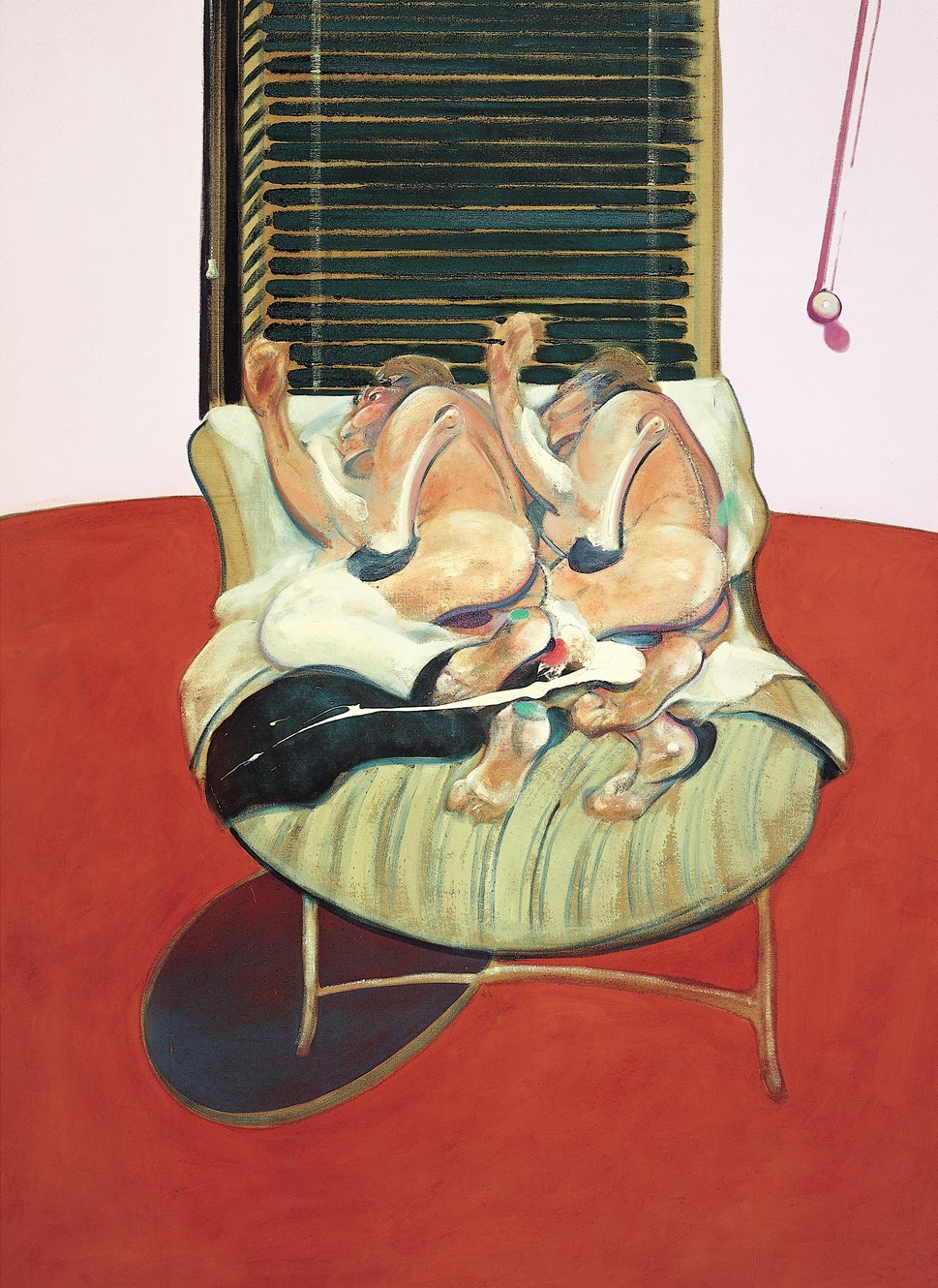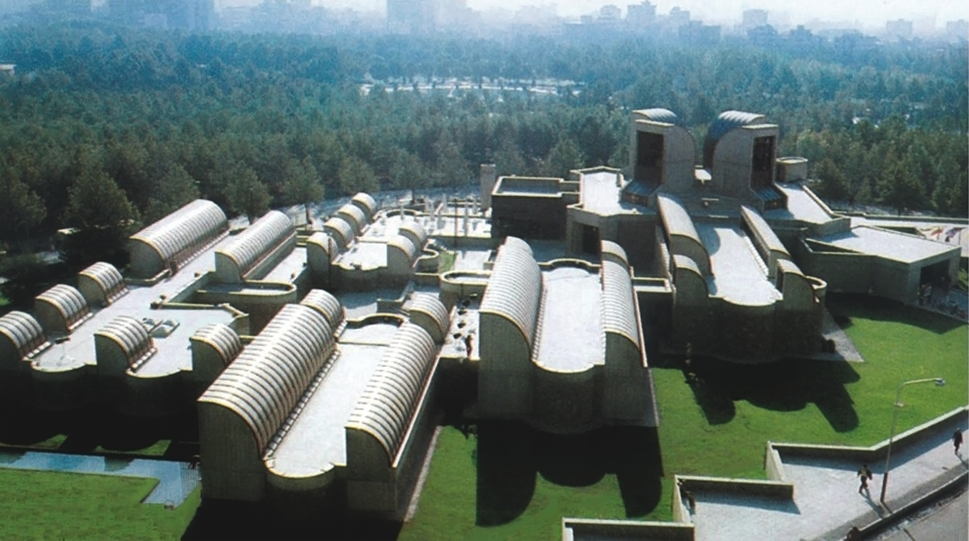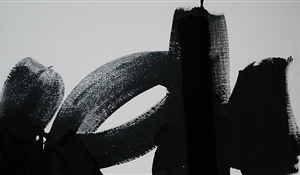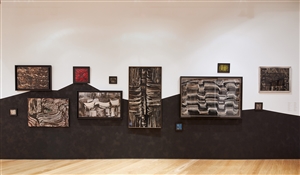An Inquiry into the Basement of Tehran Museum of Contemporary Art
17 Aug 2022The Undergrounds of the Equestrian Arena of Jalaliyeh
The end of the descending ramp leads to a path that like one of the panels of Bacon's painting is not hidden but forbidden; a crack on the wall as if an alluring absence. For a fantasizer, the crevice at the end of the revolving path with its few steps has the mysterious lure of all basements.
When I entered the museum's basement for the first time, what caught my eye was not the art pieces but the architecture of the place: rectangular chambers that unlike the galleries and corridors upstairs are not interconnected yet pull everything inside with a calm and enigmatic desire – just like an instinct. Dissimilar to the museum building, the basement neither folds in nor winds around itself, but appears to be constantly hiding in itself.
On 13 October 1977, at the opening ceremony, before attending Monir Farmanfarmaian's residence for dinner, Rockefeller may have called the Tehran Museum of Contemporary Art "the most beautiful museum" during a formal-ceremonial speech. He later, however, combined the art of political language with the sly heritage of British literature, adding that this place is a complement to Guggenheim Museum.
To date, at least, none of our museums have been as controversial as the Museum of Contemporary Art among the architects. While Dariush Borbor and the crowd on that side regard the museum as a "big copy", Kamran Diba - and his supporters – have always defended themselves against such accusations by pointing at the inspirations and incorporations of Iranian architecture: the spirit of the Hashtis (arctic entries) and Charsous (intersections), skylights resembling desert windcatchers, the twilight color of copper, the desert color of concrete, and the wind-grooved stones.
Perhaps, there were several artists contemporary with Diba that envisioned more ambitious structures like Jules Bourdais intending to illuminate Paris with a solar tower, or Vladimir Tatlin, wishing to build a cosmic Babylonian tower in Saint Petersburg, the plans of which still exist in Stockholm Museum of Modern Art. The tilted axis of the tower was to point at the polar star and the interior cores of the structure were to rotate as the celestial bodies moved. It would have been a grimace at the Book of Genesis as he and his poet friend, Khlebnikov, were planning to transfer all languages to a common root.
However, the architect of the Tehran Museum of Contemporary Art never denied his creation being a composite architecture, influenced by the architecture of other places such as the Guggenheim Museum; therefore, it is not unfair to avert our eyes from architectural suppositions and accept what the architect says and, indeed, focus our attention on the open spaces of the halls, the gentle slopes, and the corridors that stand behind us as if an imaginary lover, holding our arms, and taking us from one gallery to the next while kissing our hair.
You will not get lost in these corridors, but be constantly found.
We know that the Laleh Park and the museum were built on a land that used to be the Jalaliyeh Equestrian Square. In my mind, I have always searched for a metaphorical connection between the rotating paths of the museum and the circling tracks in which the horses once ran.
But, eventually, these revolving passageways lead to a present yet absent area: under the ground.
For someone like me, a person with a lifetime of daydreaming, it is impossible not to be distracted by the underworld of those nine galleries. The seductive serpentine with its playful slant has a hidden desire and haste to go underground, to glide inside the ground, to pull everything in a secret suction, so much so that every time I have walked there, it has been able to gather my distracted and scattered thoughts inside itself.

Image courtesy: www.caoi.ir
The first time I went to the basement was to see Rauschenberg's work up close for a note I was writing. When I encountered the giant panels of a work by a neo-Dadaist, I thought to myself that the cool scent of paint and wood and another smell that I have not yet discovered was the smell of the basement. Passing by the hanging rails, the Hackneys, Gauguin, Matine Daftary, and Lautrec, the icy walls of the basement could absorb one like a whisper. The basements already appear like worlds on the edge of reality, disappearing at any moment, never mind when the colors of Rothko, Klein, Morris Louis, and de Kooning are arranged in a way as if they were rare and purebred horses in parallel stalls of a secret stable. Who would believe that a few meters away, above our head, people are prepared to knock each other out for a parking spot to go to the Etka Store?
That first time, I did a few more rounds across the line of works, watching the ceiling and walls of the basement. I cannot be blamed, after all, anyone in such geography knows that if she remains a descendent of her ancestors it is to some extent owing to the basements.
Eight thousand years ago, the worshipers of Mehr (Mithra) built an underground city out of necessity due to weather problems and animal attacks. Such maneuvers and standing against nature granted them power like the armadillos – the underground kings. The history of our underground mass development does not end here. Fleeing from regional wars and looting was what led to the construction of a multistorey city on the outskirts of Kashan with labyrinthine passageways and chambers.
One more thing: fearing the Mongols, we also took refuge underground.
The pyramids of Egypt, the tombs of the Ottoman era, and underground shelters and cities are the spaces that pass in my thoughts as I walk around in the basement. After all, the underground of the museum functioned as more than a treasury in two historical periods.
With the 1979 Revolution in Iran, when the museum pieces had to be anxiously relocated to the basement to prevent their destruction, annihilation, confiscation, plunder, and other wounded emotions, this place was serving as what would a few years later become the main purpose of all basements in the city: providing refuge for anything that was in the vicinity of nonexistence and on the unbalanced side of existence.
History must be really humorous for only one year after the opening of the museum, the artworks found themselves in the basement, some of which were never allowed to return above from then on. Similar to the parts of our lives that had to go underground and stay hidden ever since. As the museum pieces were purchased in the late 70s, suffering such a fate, their state is not unlike those born in the late 70s and early 80s. Like us, those works could escape the circumstances of the time unharmed, in which the undergrounds were the only shelters. Here, however, a humorous and metaphorical interpretation can be made of Barthes saying that architecture should be simultaneously the projection of an impossibility and the execution of functional order.
During the Iraq-Iran war, the museum became an asylum for the families of the employees. I have pictured this beautiful story many times. The years when the treasure collection was protected in the basement while the families of the employees took refuge in a separate compartment at the same place. These were what the sequestrator of the time and his son told me. His son explains that he used to sit on the museum ramp with the other children.
What did the museum and its basement look like at that time? I did not find any photographs.
This account cannot be left out either that, after the revolution, the museum was to be evacuated and converted into a Hosseinieh (Shia religion congregation hall). That means that the basement would have been filled with signs, banners, flags, tents, chains, and large samovars. Whoever opposed the plan must have realized that it might have been possible for the unsheltered children to sit on the ramp, but the movement of the mourning procession on the slopes of the corridors would not have ended well at all. Not to mention sitting in separate galleries would have prevented the mourners to see the Madah (the singer of the events Karbala).
I also searched a lot for the one who made this proposal.
Basement means emergency, concealing or getting concealed, and guarding everything we have ever needed; food, water, and the tools of war.
Wells, Qanats (underground aqueduct systems), Ab anbars (water reservoirs), and ice houses are all strangely entangled with the need to survive. These spaces, with their minimum humidity, almost constant temperature, and - more importantly - isolation and silence are as essential to any place as the need for humans to be in solitude. An area where unspeakable secrets can be explored and buried. A reservoir where we can store our madness and melancholia.

Francis Bacon | "Two Figures Lying on a Bed with Attendants" | 1968 | Oil and pastel on canvas | the center piece of a Triptych
Of all the works that have always remained in the basement of the museum, we have always thought of the forbidden ones: Picasso's "Painter and Model", Bacon's middle piece of the Triptych, and "Gabrielle with Open Blouse".
Basements are the introverted parts of any structure. Spaces that not everyone can access, like a writer's notebook, a secret meeting place for two people, and anywhere to take refuge in to avoid the splinters of daily life.
The stories always lie in such places that one should tunnel through and fall in. So here's where my true color is revealed to me. It is no coincidence that this text is not about the spectacular building on Kargar Street, but its basement.
When it comes to the basement of the museum, we no longer need to take the side of any of the architects. The basement is not architecture, but literature; it is stories I have not heard and we do not yet know.
If we descend those famous skylights (architecture) and watch the museum from the basement (literature), we will no longer look for a superhero for this city. We will see a character in a novel that has survived through suffering and happiness with beautiful weaknesses in the real world that neither its copper roof has Bourdais' dream of a mirror system to illuminate the city, nor is its concrete structure supposed to lead us to a common language; it can even be said that as time passes, we may have to see it as a large gallery rather than a museum. But this time, as we get to Haraguchi's oil pool, our gaze may be more on that turn and behind that wall which has always given refuge like a beloved solitude or seclusion.






